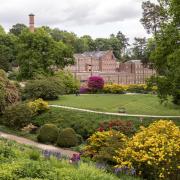The seven best bulbs for spring gardens and how to grow them

As the air takes on that autumn feel and summer blooms fade in our gardens, it is time to plant bulbs for spring. Bulbs offer form and structure to any border, providing a wonderful tapestry of colour.
So, what is a bulb? It’s a complete plant in miniature. The embryonic flower is at the centre, surrounded by fleshy scales that store nutrients to sustain the plant during its dormant period. A papery outer skin provides protection.
Bulbs are versatile, can be grown in the greenhouse, containers or rockeries and can last a long time with a bit of care.
Here are some tried and trusted varieties:
1. NARCISSUS Daffodil
With their symbols of rebirth and new beginnings, daffodils offer varieties that flower from January to April. Happy to grow in full sun, dappled shade or partial shade and work well naturalised in grass. The majority are hardy enough to remain in the ground over winter, forming large clumps in a few years.
Poet’s Narcissus (Pheasant’s Eye) is rich in nectar for pollinating insects.
Bunch-flowered Tazetta is a less hardy variety but well worth the effort.
Standing only 15cm high Tête-à-tête is ideal for planting in patio containers. The deep golden flowers appear in early spring with stems bearing up to three blooms.
Rip van Winkle is fluffy in appearance with multi-petals that nod in the breeze. Best grown in a sheltered spot away from strong winds.
And who could resist the charm of Minnow for front-of-the border appeal? A miniature which produces up to five small creamy yellow flowers per stem.
I love Jetfire, with bright yellow petals and orange trumpets that glow brighter as the flowers develop, bringing cheer to the garden when little else is in flower. I add them to containers and cover them with annuals once the foliage has died down.
2. TULIPA Tulip
Tulips symbolise perfect love and have certainly stolen my heart. There is a certain poise and elegance about them, and they look beautiful as a cut flower.
They will grow in any reasonable soil as long as they don’t become waterlogged and prefer a sunny position away from the wind. Low growing varieties are also available if your garden is on an exposed site.
Colours range from white (White Dream) to near black (Queen of the Night), with a selection of yellow, orange, pink, purple and reds in between. There are single and bi-coloured varieties, feather flamed and streak-marked flowers as in the Rembrandt tulips. Red Riding Hood is accompanied by variegated leaves.
Flowers come in different forms – frilly edged, double bloomed, star, lily and cup-shaped. Parrot tulips are the most flamboyant of them all; brightly coloured or two-toned, their large flowers have wavy, twisted or deeply frilled petals.
My favourite is sweetly fragranced Ballerina, aptly named with delicate stems and petals in zingy orange. Perfect for containers.
3. IRIS
Bulb Iris form beautiful colours and unusual markings among erect strap-like foliage. They are clump-forming. Need to be grown in light soil in a sunny site. Comes in standard sizes 55-65cm and dwarf varieties from 7.5-10cm in height that flower earlier in the season. Eye Catcher makes for a stunning display. Truly a work of art producing white flowers with purple stripes and yellow markings edged with lilac- purple dots.
4. MUSCARI Grape Hyacinth
Though muscari does not share the glamour of some of the showier bulbs, it is a great choice for filling gaps in planting and will grow happily among primroses and tulips. Plant these little blue jewels scattered in informal groups below trees and shrubs 1-cm deep and 5cm apart to form a beautiful display and solitary hairy-footed flower bees will love you forever. Leaves appear before the flowers. Too much rich soil will give you more luxuriant leaf and less flower.
5. LEOCOJUM Snowflake
Often confused with snowdrops because of their bell-shaped flowers made up of six petals. Later to flower than snowdrops. Easy to grow and multiplies freely in most gardens provided the soil is moist enough. It’s been known to withstand flooding and standing water, so it’s an ideal choice for bog gardens and pond-side planting.
6. ANEMONE Windflower
The daisy-like blooms of Anemone blanda that appear from February to April are anything but bland. Makes for low growing drifts of colour beneath trees and shrubs, mainly in blue, but pink and white are also available.
7. ORNITHOGALUM UMBELLATUM Star of Bethlehem
Flowers in April/May. Forms carpets of low-growing foliage topped with numerous starry white flowers. Rich in pollen, the flowers have the charming habit of closing at night. Grows in any well-drained soil in sun or shade.
Tips on Growing Bulbs
1. Choose bulbs carefully and plant straight after buying
2. Grow in informal groups rather than in a straight line
3. Plant bulbs deeper if you share your garden with squirrels
4. Remove dead flower heads to prevent seeds forming
5. Leave the foliage to die down naturally so the leaves can make food
for the developing bulb
6. Lift and divide clumps every 4 or 5 years
7. Plant dwarf varieties in containers and front of the border


























![Stephen Webb [Frank-N-Furter], Richard Meek [Brad], Haley Flaherty [Janet] & cast](/resources/images/128x89/1x/17679473.jpg)
![Stephen Webb [Frank-N-Furter], Richard Meek [Brad], Haley Flaherty [Janet] & cast](/resources/images/180x180/1x/17679473.jpg)
